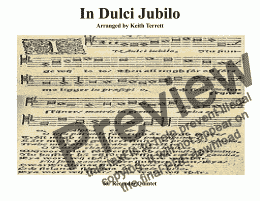Ready to print
You have already purchased this music, but not yet printed it.
This page is just a preview and does not allow printing. To print your purchase, go to the My purchases page in your account and click the relevant print icon.
In Dulci Jubilo ("In sweet rejoicing") for Recorder Quintet

Already purchased!
You have already purchased this score. To download and print the PDF file of this score, click the 'Print' button above the score. The purchases page in your account also shows your items available to print.
This score is free!
Buy this score and parts
In Dulci Jubilo ("In sweet rejoicing") for Recorder Quintet
$11.99
$3.99
from $1.60
Preview individual parts:
Instant download
You are purchasing high quality sheet music PDF files suitable for printing or viewing on digital devices.A little transcription of In Dulci Jubilo for Recorder Quintet.
In dulci jubilo ("In sweet rejoicing") is a traditional Christmas carol. In its original setting, the carol is a macaronic text of German and Latin dating from the Middle Ages. Subsequent translations into English, such as J.M. Neale’s arrangement "Good Christian Men, Rejoice" have increased its popularity, and Robert Pearsall’s 1837 macaronic translation is a mainstay of the Christmas Nine Lessons and Carols repertoire. J.S. Bach’s chorale prelude based on the tune (BWV 729) is also a traditional postlude for Christmas service. Dieterich Buxtehude set the melody as a chorale-cantata in 1683 for soprano, alto and bass accompanied by two violins and continuo (BuxWV 52) and as a chorale prelude for organ (BuxWV 197) c. 1690.
Johann Sebastian Bach set this melody several times: as a chorale in BWV 368; and then for organ in BWV 608 as a double canon in his Orgelbüchlein and in BWV 729 and BWV 751 as a chorale prelude. Commentators agree, however, that BWV 751 is too simple and undeveloped to be the work of Bach. Bach also used the opening phrase of the melody as a fugal subject for two other choral preludes, BWV 703 (Gottes Sohn ist kommen) and BWV 724 (Gott durch deine Güte). BWV 729, written by Bach to accompany congregational singing in Arnstadt, is traditionally performed as the first organ voluntary at the end of the Festival of Nine Lessons and Carols at King’s College, Cambridge. This voluntary was first introduced to the service in 1938 by organ scholar Douglas Guest. Franz Liszt included the carol in his piano suite Weihnachtsbaum in the movement entitled Die Hirten an der Krippe (The Shepherds at the Manger). Norman Dello Joio uses the theme as the basis of his "Variants on a Medieval Tune" for wind ensemble. Ronald Corp composed a setting of In Dulci Jubilo for unaccompanied SATB choir in 1976.
The original song text, a macaronic alternation of Medieval German and Latin, is thought to have been written by the German mystic Heinrich Seuse circa 1328. According to folklore, Seuse heard angels sing these words and joined them in a dance of worship.In his biography (or perhaps autobiography), it was written:
Now this same angel came up to the Servant (Suso) brightly, and said that God had sent him down to him, to bring him heavenly joys amid his sufferings; adding that he must cast off all his sorrows from his mind and bear them company, and that he must also dance with them in heavenly fashion. Then they drew the Servant by the hand into the dance, and the youth began a joyous song about the infant Jesus …
The tune first appears in Codex 1305, a manuscript in Leipzig University Library dating from c.1400, although it has been suggested that the melody may have existed in Europe prior to this date. In print, the tune was included in Geistliche Lieder, a 1533 Lutheran hymnal by Joseph Klug. It also appears in Michael Vehe’s Gesangbuch of 1537. In 1545, another verse was added, possibly by Martin Luther. This was included in Valentin Babst’s Geistliche Lieder, printed in Leipzig. The melody was also popular elsewhere in Europe, and appears in a Swedish/Latin version in the 1582 Finnish songbook Piae Cantiones, a collection of sacred and secular medieval songs.
The tune appears in Michael Praetorius’s Polyhymnia Caduceatrix & Panegyrica collection of 1619.
A polyphonic arrangement for 8 voices was made by Robert L. Pearsall (1795-1856), this being later adapted for 4 voices, the most commonly performed version, by W. J. Westbrook (1831-1894).
There have been a number of translations of the Latin/German poem into English. The most popular that keeps the macaronic structure is Robert Lucas de Pearsall’s 1837 translation, which retains the Latin phrases and substitutes English for German. A 2008 survey by BBC Music Magazine found this to be the second most popular choral Christmas carol with British cathedral organists and choirmasters.
Alternatively, a looser translation produced in 1853 by John Mason Neale titles the work "Good Christian Men, Rejoice". This translation is often criticised. In 1921, H. J. Massé wrote that it was an example of "musical wrong doing … involving the mutilation of the rhythm of that grand tune In dulci jubilo to the English words Good Christian Men Rejoice. It is inconceivable that anyone of any real musical culture should have lent himself to this tinkering with a perfect tune for the sake of fitting it perforce to works of inferior merit." He goes on to cite a more appropriate English translation from 1567 by John Wedderburn as a more "worthy effort".
Still another English translation, made in the 19th century by Arthur T. Russell and featured in several Lutheran hymnals, renders the work as "Now Sing We, Now Rejoice".



